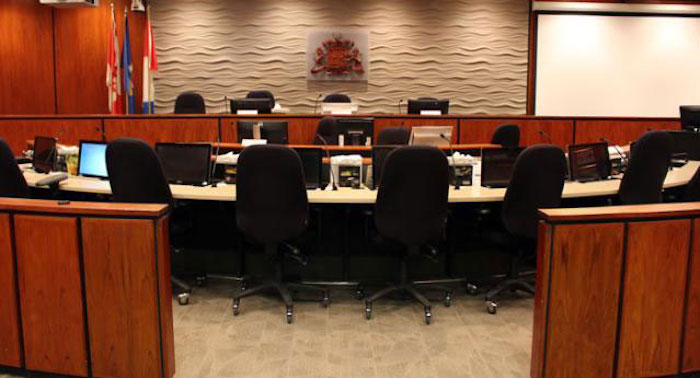Alberta
Investigation concludes suspect convinced girlfriend to lie to police

News Release from ASIRT (Alberta Serious Incident Response Team)
Investigation concluded into use of force during EPS arrest
On Aug. 1, 2018, pursuant to Section 46.1 of the Police Act, the Director of Law Enforcement (DLE) assigned ASIRT to investigate the circumstances surrounding a vehicle pursuit and subsequent arrest of a 31-year-old man. The man had been arrested by members of the Edmonton Police Service (EPS) on July 30 following a brief vehicle pursuit which had resulted in serious injury to an uninvolved pedestrian, and was terminated by intentional contact made by two EPS vehicles.
As is required by the Police Act, these events were reported to the DLE and, based on the information that was known at the time, EPS was directed to maintain conduct of the investigation. Several days later, while being interviewed in relation to that investigation, the man alleged that he had been assaulted during the course of his arrest and had sustained several injuries. This additional information was again reported to the DLE, and ASIRT was directed to assume conduct of the investigation into both the pursuit and any force used during the subsequent arrest of the affected person.
On July 30, 2018, at approximately 12:30 a.m., EPS members operating a marked police vehicle conducted a database check on a red Buick Rendezvous SUV, which revealed the vehicle’s licence plate had been reported stolen. Members followed the vehicle without activating their emergency equipment until the SUV stopped and the driver, later identified as the 31-year-old man, exited. Police then activated their vehicle’s emergency equipment, but the man re-entered the SUV and drove away at a high rate of speed.
Police followed the SUV with emergency equipment activated, and observed the SUV run a red light at 101 Street and 107 Avenue. At this point, several other EPS vehicles had entered the area and additional members were able to observe the SUV. During its flight from police, the vehicle mounted the sidewalk at 102 Street and struck a female pedestrian and a light post. Officers who observed the collision formed the opinion that the collision with the pedestrian was deliberate. Overt action had been required to mount the sidewalk and strike the pedestrian, who was standing in a well-lit area. As well, the man’s vehicle had had an unobstructed path forward with no observable reason or cause to leave the roadway and mount the sidewalk.
After striking the pedestrian and the pole, the SUV continued east on 107 Avenue, with police continuing pursuit. A second EPS vehicle remained at the scene of the collision to render aid to the female pedestrian, who had sustained numerous serious injuries. Having witnessed what appeared to be the deliberate use of the SUV to strike a pedestrian, the driver of the lead EPS vehicle indicated that he believed it was necessary to attempt to end the criminal flight using deliberate vehicle contact. He deliberately struck the rear driver’s side of the SUV, but this tactic failed to stop the vehicle. A marked police van subsequently made deliberate contact with the SUV, this time striking it head-on, and brought the SUV to a halt. The man exited the driver’s seat of the SUV and fled on foot southbound on 103 Street.
Three police officers pursued the man on foot. During this pursuit, the lead officer deployed his conducted energy weapon (CEW), which was successful in bringing the man to the ground. The officer verbally commanded the man to roll onto his stomach, as he had turned onto his back. The man was initially compliant, but resisted when officers attempted to handcuff him. The officer reactivated the CEW, and the man was handcuffed while the CEW was still activated.
Once in custody, the man was observed to be sweating profusely, making spastic movements and acting in a manner that indicated to the arresting officers that he was under the influence of methamphetamine. Accordingly, after searching him, EMS transported the man to hospital.
Medical records obtained during the course of the ASIRT investigation confirmed that at the time of his examination at hospital, the man had a two-centimetre laceration to his forehead which was not actively bleeding, two abrasions on his shoulder area and mild swelling of the front of his head. A CT scan revealed the presence of an age-indeterminate nasal fracture, meaning that doctors were unable to determine whether the nasal fracture had occurred during this event or earlier. Medical staff determined that the man was fit for incarceration, and released him from hospital that same day.
As previously indicated, shortly after he was incarcerated, EPS interviewed the man in the course of their investigation. During that interview, the man described his arrest, discussed his injuries, and asked the interviewer about the condition of the woman he had hit during the incident. Once ASIRT assumed conduct of the investigation, the man was interviewed again – this time by an ASIRT investigator. The man described his flight from police and the collision with the pedestrian but stated that a police vehicle had struck him before the collision with the pedestrian. He also stated that he did not remember hitting anyone.
The man stated that his girlfriend ran away from police following the collision but stopped to watch his arrest. He stated that she told him that at one point six police officers were beating him. The man stated that he did not remember this, but recommended that ASIRT interview his girlfriend. He further stated that at the time of the incident he was under the influence of methamphetamine, which he had used approximately five hours before the incident. He stated that his girlfriend was under the influence of heroin, which she had consumed approximately one hour before the incident.
The man’s girlfriend was interviewed twice during the course of this investigation, once by EPS and once by ASIRT. During the first interview by EPS, she stated that she had been the lone passenger in the vehicle being operated by her boyfriend. She indicated that he had lost control of the vehicle while turning and began to drive on the sidewalk before striking a lamppost. She stated that neither of them was aware at the time that they had struck a pedestrian. During the statement, she indicated that when the final collision with the police vehicle occurred, the man jumped out of the vehicle first and was pursued by police. She stated that she ran from the scene to a friend’s house, where, through a third party, she contacted her boyfriend in jail, but advised that they did not discuss the incident. In addition to describing the events, she confirmed the man’s statements regarding her use of heroin prior to the incident.
The next day, after the case was assigned to ASIRT, the man’s girlfriend was interviewed again by ASIRT investigators. During this interview, she confirmed that she had recently spoken to her boyfriend and now suggested that the police had struck the SUV, causing the collision with the pedestrian and minimizing the man’s role in the incident. She now stated that following the final collision, she ran and hid under a car that was approximately 10 to 20 metres away. As she watched her boyfriend’s arrest, she alleged she saw police assault him.
As a result of the discrepancies between their various versions of the incident and the conversations that took place between them after the man’s arrest, ASIRT investigators took the unusual step of obtaining a judicial authorization for access to the man’s communications while in custody at the Edmonton Remand Centre. The recorded calls revealed repeated attempts by the man to influence the evidence of his girlfriend in conversations directly with her and with other parties. On several occasions, the man referenced the impact that her assistance would have on his chances of getting bail on the charges arising from the incident. During two of the calls, the man’s girlfriend described the striking of the pedestrian, saying that she remembered her being in the way, running and screaming. The man advised her to downplay that aspect of the story when dealing with the police, and to state that she was not sure of the details.
During the calls, the man repeatedly exaggerated the extent of his dealings with police, stating that he had smashed four police vehicles, that he had four CEWs used upon him, had received four broken bones in his face during the incident, and had sustained dog bites during his arrest. His girlfriend’s response to these statements clearly demonstrated that she had not witnessed the arrest. It appeared that in a number of the exchanges, the man attempted to instil fear in his girlfriend in order to ensure her cooperation, and encouraged her to turn herself in to police, which he repeatedly suggested would help him.
In addition to the recorded calls, the independent evidence of three civilian witnesses and CCTV video from an area business confirmed that the man’s girlfriend did not witness his arrest as described in her second statement, but rather had immediately fled the area as she had initially described.
Despite being under no obligation to do so, each of the three police officers directly involved in the arrest of the man provided voluntary statements to ASIRT for use during the investigation. One officer acknowledged deploying his CEW during the foot pursuit of the man, which resulted in the man falling to the ground. When the man continued to struggle on the ground, and was described as actively resistant, the officer reactivated his CEW, which allowed him, with the assistance of the other two involved officers, to place the man in handcuffs. The three officers directly involved in the man’s arrest, along with all witness officers interviewed, denied participating in or witnessing any significant use of force as described by the man and his girlfriend.
On the basis of the information available to police during this incident, they were lawfully placed to arrest the man in relation to a number of Criminal Code offences, including possession of stolen property and criminal flight causing bodily harm. As the officers were engaged in the lawful execution of their duty, they were authorized by Sec. 25 of the Criminal Code to use a reasonable amount of force necessary to carry out their duties.
While the description of the amount of force used during the incident varies widely between the descriptions provided by police and the man and his girlfriend, when looking at the evidence in this matter as a whole, it is impossible to place any weight whatsoever on the versions offered by the man and his girlfriend.
In addition to the significant inconsistencies between the versions offered by both the man and his girlfriend in their own multiple statements, which would on their own significantly compromise the ability to rely upon their evidence, the recorded attempts by the man to influence the evidence of his girlfriend in hopes of convincing her to tailor her evidence to match his own is fatal to the credibility of both witnesses. Independent evidence conclusively established that the girlfriend was not present to witness the arrest.
Based on the available reliable evidence, the force used to arrest the man was both reasonable and necessary. Once restrained in handcuffs, there were no additional uses of force, and the man was taken into custody without further incident. Furthermore, it is clear from an assessment of all the evidence in this matter that the cause of the initial collision with the pedestrian was the man’s deliberate driving pattern and that there was no physical contact with the SUV by any police vehicle before the pedestrian was struck.
There are no reasonable grounds, nor reasonable suspicion, to believe that any of the officers committed any Criminal Code offence(s). The officers were lawfully placed in their actions with the man, and the force employed was reasonable and necessary in the circumstances. As such, no charges are appropriate, and ASIRT’s involvement in the matter is concluded.
ASIRT’s mandate is to effectively, independently and objectively investigate incidents involving Alberta’s police that have resulted in serious injury or death to any person, as well as serious or sensitive allegations of police misconduct.
Alberta
Alberta government announces review of Trudeau’s euthanasia regime

From LifeSiteNews
Alberta announced it ‘is reviewing how MAID is regulated to ensure there is a consistent process as well as oversight that protects vulnerable Albertans, specifically those living with disabilities or suffering from mental health challenges.’
The Conservative provincial government of Alberta is pushing back against the Canadian federal government’s continued desire to expand euthanasia in the nation, saying it will launch a review of the legislation and policies surrounding the grim practice, including a period of public engagement.
The United Conservative Party (UCP) government under Premier Danielle Smith in a press release said the province needs to make sure that robust safeguards and procedures are in place to protect vulnerable people from being coerced into getting euthanatized under the MAiD (Medical Assistance in Dying) program.
“Alberta’s government is reviewing how MAID is regulated to ensure there is a consistent process as well as oversight that protects vulnerable Albertans, specifically those living with disabilities or suffering from mental health challenges,” said the government Monday.
The government said a online survey regarding MAiD open to all Albertans who have opinions about the deadly practice will be available until December 20.
“We recognize that medical assistance in dying is a very complex and often personal issue and is an important, sensitive and emotional matter for patients and their families,” said Alberta’s Minister of Justice and Attorney General Mickey Amery.
Amery said it is important to ensure this process has the “necessary supports to protect the most vulnerable.”
The government said that it will also be engaging with academics, medical associations, public bodies, as well as religious organizations and “regulatory bodies, advocacy groups” regarding MAiD
The government said all information gathered through this consultation will “help inform the Alberta government’s planning and policy decision making, including potential legislative changes regarding MAID in Alberta.”
When it comes to MAiD, Prime Minister Justin Trudeau’s Liberal government sought to expand it from the chronically and terminally ill to those suffering solely from mental illness.
However, in February, after pushback from pro-life, medical, and mental health groups as well as most of Canada’s provinces, the federal government delayed the mental illness expansion until 2027.
Alberta’s Minister of Mental Health and Addiction Dan Williams said that the UCP government has been “clear” that it does not “support the provision of medically assisted suicide for vulnerable Albertans facing mental illness as their primary purpose for seeking their own death.”
“Instead, our goal is to build a continuum of care where vulnerable Albertans can live in long-term health and fulfilment. We look forward to the feedback of Albertans as we proceed with this important issue,” he noted.
The Alberta government said that as MAiD is “federally legislated and regulated” it is main job will be to try and make sure that it protects “vulnerable individuals” as much as possible.
Alberta’s Minister of Health Adriana LaGrange reaffirmed that the Alberta government “does not support expanding MAID eligibility to include those facing depression or mental illness and continues to call on the federal government to end this policy altogether.”
The number of Canadians killed by lethal injection under the nation’s MAiD program since 2016 stands at close to 65,000, with an estimated 16,000 deaths in 2023 alone. Many fear that because the official statistics are manipulated the number may be even higher.
To combat Canadians being coerced into MAiD, which LifeSiteNews has covered, the combat pro-life Delta Hospice Society (DHS) is offering a free “Do Not Euthanize Defense Kit” to help vulnerable people “protect themselves” from any healthcare workers who might push euthanasia on the defenseless.
Alberta
Early Success: 33 Nurse Practitioners already working independently across Alberta

Nurse practitioners expand primary care access |
The Alberta government’s Nurse Practitioner Primary Care program is showing early signs of success, with 33 nurse practitioners already practising independently in communities across the province.
Alberta’s government is committed to strengthening Alberta’s primary health care system, recognizing that innovative approaches are essential to improving access. To further this commitment, the Nurse Practitioner Primary Care Program was launched in April, allowing nurse practitioners to practise comprehensive patient care autonomously, either by operating their own practices or working independently within existing primary care settings.
Since being announced, the program has garnered a promising response. A total of 67 applications have been submitted, with 56 approved. Of those, 33 nurse practitioners are now practising autonomously in communities throughout Alberta, including in rural locations such as Beaverlodge, Coaldale, Cold Lake, Consort, Morley, Picture Butte, Three Hills, Two Hills, Vegreville and Vermilion.
“I am thrilled about the interest in this program, as nurse practitioners are a key part of the solution to provide Albertans with greater access to the primary health care services they need.”
To participate in the program, nurse practitioners are required to commit to providing a set number of hours of medically necessary primary care services, maintain a panel size of at least 900 patients, offer after-hours access on weekends, evenings or holidays, and accept walk-in appointments until a panel size reaches 900 patients.
With 33 nurse practitioners practising independently, about 30,000 more Albertans will have access to the primary health care they need. Once the remaining 23 approved applicants begin practising, primary health care access will expand to almost 21,000 more Albertans.
“Enabling nurse practitioners to practise independently is great news for rural Alberta. This is one more way our government is ensuring communities will have access to the care they need, closer to home.”
“Nurse practitioners are highly skilled health care professionals and an invaluable part of our health care system. The Nurse Practitioner Primary Care Program is the right step to ensuring all Albertans can receive care where and when they need it.”
“The NPAA wishes to thank the Alberta government for recognizing the vital role NPs play in the health care system. Nurse practitioners have long advocated to operate their own practices and are ready to meet the growing health care needs of Albertans. This initiative will ensure that more people receive the timely and comprehensive care they deserve.”
The Nurse Practitioner Primary Care program not only expands access to primary care services across the province but also enables nurse practitioners to practise to their full scope, providing another vital access point for Albertans to receive timely, high-quality care when and where they need it most.
Quick facts
- Through the Nurse Practitioner Primary Care Program, nurse practitioners receive about 80 per cent of the compensation that fee-for-service family physicians earn for providing comprehensive primary care.
- Compensation for nurse practitioners is determined based on panel size (the number of patients under their care) and the number of patient care hours provided.
- Nurse practitioners have completed graduate studies and are regulated by the College of Registered Nurses of Alberta.
- For the second consecutive year, a record number of registrants renewed their permits with the College of Registered Nurses of Alberta (CRNA) to continue practising nursing in Alberta.
- There were more than 44,798 registrants and a 15 per cent increase in nurse practitioners.
- Data from the Nurse Practitioner Primary Care Program show:
- Nine applicants plan to work on First Nations reserves or Metis Settlements.
- Parts of the province where nurse practitioners are practising: Calgary (12), Edmonton (five), central (six), north (three) and south (seven).
- Participating nurse practitioners who practise in eligible communities for the Rural, Remote and Northern Program will be provided funding as an incentive to practise in rural or remote areas.
- Participating nurse practitioners are also eligible for the Panel Management Support Program, which helps offset costs for physicians and nurse practitioners to provide comprehensive care as their patient panels grow.
Related information
-

 Brownstone Institute2 days ago
Brownstone Institute2 days agoThe Most Devastating Report So Far
-

 Business2 days ago
Business2 days agoCarbon tax bureaucracy costs taxpayers $800 million
-

 ESG1 day ago
ESG1 day agoCan’t afford Rent? Groceries for your kids? Trudeau says suck it up and pay the tax!
-

 Daily Caller1 day ago
Daily Caller1 day agoLos Angeles Passes ‘Sanctuary City’ Ordinance In Wake Of Trump’s Deportation Plan
-

 John Stossel1 day ago
John Stossel1 day agoGreen Energy Needs Minerals, Yet America Blocks New Mines
-

 COVID-192 days ago
COVID-192 days agoDr. McCullough praises RFK Jr., urges him to pull COVID shots from the market
-

 Alberta1 day ago
Alberta1 day agoProvince considering new Red Deer River reservoir east of Red Deer
-

 MAiD2 days ago
MAiD2 days agoOver 40% of people euthanized in Ontario lived in poorest parts of the province: government data





